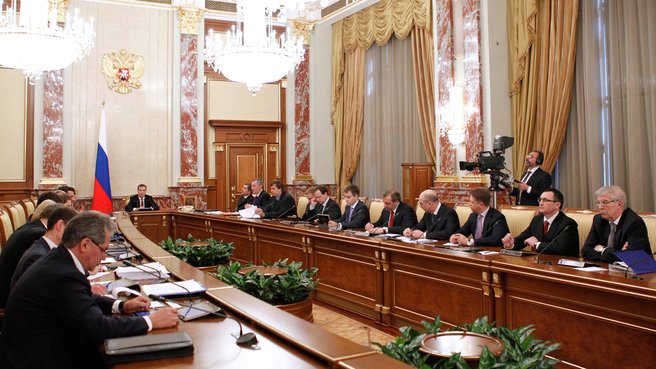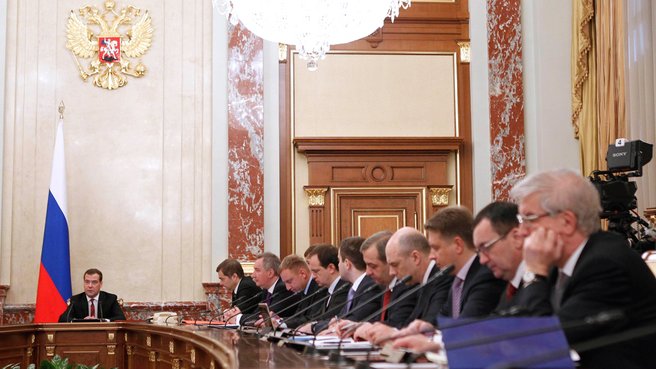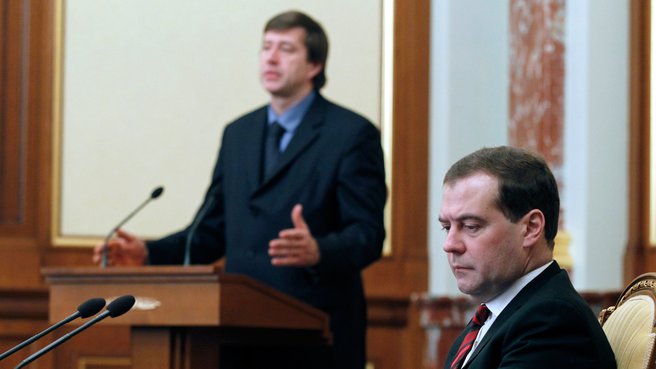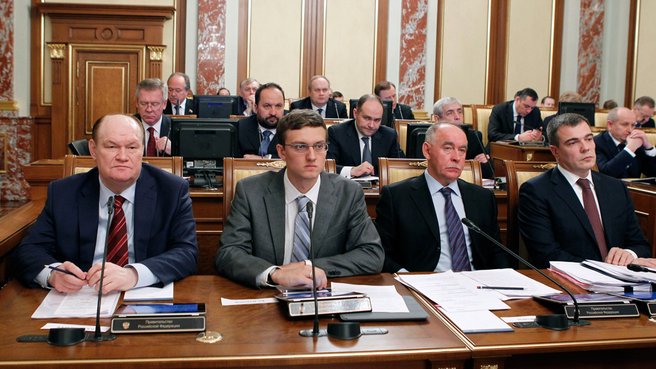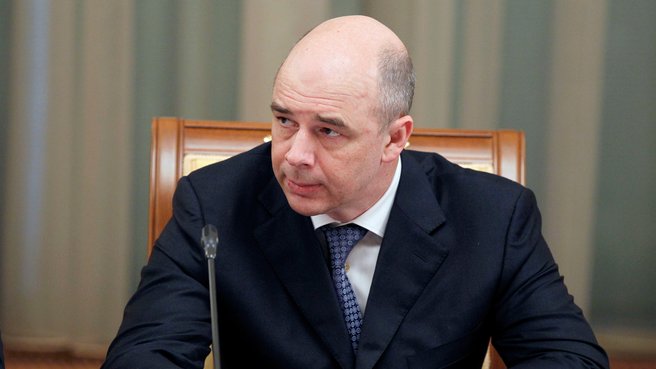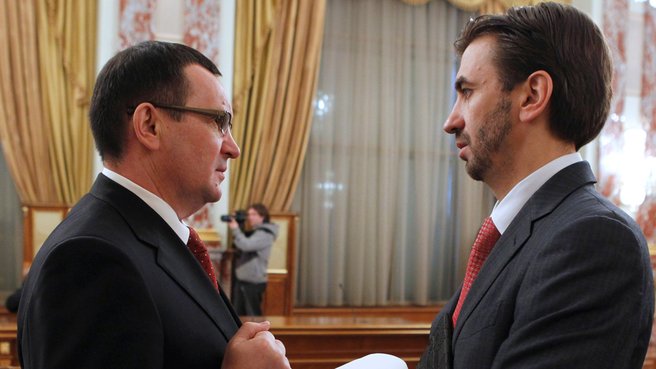Agenda: approval of the Justice state programme; improving inter-budget relations in terms of providing incentives to the Russian regions to attract investment, plus 17 other issues.
Transcript:
Dmitry Medvedev: Colleagues, today we will examine the state programme Justice. The goal of this programme is clear: the development of the state and society in the modern world is inextricably linked to the legal culture and access to legal assistance. Naturally, it is also linked to fair trials and the unavoidability of punishment in those cases where it is necessary. In recent years, we have been improving the quality of the judicial system, we have been making it more open and improving the protection of the rights and interests of individuals and organisations. The state programme is designed to address a number of fundamental issues in the field of justice.
Firstly, I would like to discuss improvements in the legal services market and in the mechanism for monitoring the quality of legal assistance. These services have to be provided by specially trained and certified professionals. Equally important, they must follow a certain code of corporate ethics, as is customary all over the world, and have the required legal culture, which is why there are plans to establish an online register of lawyers and notaries. And, of course, we must improve the legal literacy of the population by relying on the potential of the state, the media and modern communications in general.
Secondly, I would like to say a few words about the modernisation of judicial expertise. It is clear that cutting-edge technology, as well as sophisticated commercial and organisational schemes, are currently used to commit offences. The quality of forensic examination often affects the outcome of a case and the efficiency of combatting crime. The state programme provides for outfitting forensic expert institutions with new equipment and upgrading courses for their personnel. As a result of its implementation, forensic inquiries should take less time and become more accurate.
Third, the programme provides for improving the legal foundation and technical equipment of the Federal Bailiff Service. The burden on this service is very heavy and is constantly growing. Therefore, we should create the conditions for introducing electronic court orders and upgrading social guarantees for its employees.
One section of the programme concerns the execution of sentences. The state has been dealing with this topic for several years now. We must make this system more modern. I’m referring to such obvious matters as medical treatment of convicts. They are citizens of this country and have the right to medical aid. Professional training of former convicts is another problem. It is essential for their re-socialisation and full-scale integration into civil society.
These are ambitious plans. Implementation of the programme requires huge allocations from the federal budget – practically two trillion roubles until 2020. I hope there will be proper control over the spending of these funds.
The next issue directly concerns the improvement of the investment climate. This task depends on a host of factors, such as conditions for doing business in the regions. Today, we’ll review a package of measures submitted by the Finance Ministry. It is designed to encourage the regions to be more active in attracting investment.
Of course, we should seek a balance between fiscal capacity stabilisation and incentives. On the one hand, we must guarantee equal opportunities and uniform living standards across the country, but on the other we should give the regions more opportunities for making money themselves.
In 2011 and 2012, 32 regions that had increased their tax collection received 10 billion roubles per year from the federal budget. The largest sum – over 2.6 billion roubles – went to the Kaluga Region. The Tyumen Region received 2.5 billion roubles. A number of other large regions received more than one billion roubles.
Inter-budget transfers – one billion roubles per year – were made to those regions where executive bodies were the most efficient.
Now it has been suggested to integrate these mechanisms into one system and consider the possibility of increasing funding. Let me remind you that a considerable amount of the money earmarked for creating new industries and new jobs comes directly from the federal budget when we are talking about support for agriculture, small and medium-sized businesses, innovative activities, infrastructure modernisation, the development of certain sectors, including aviation, pharmaceutics and the development of certain areas of the country such as the North Caucasus and the Far East.
State programmes must consolidate subsidies to the regions, including subsidies for the development of the innovation-driven economy. We are planning to expand the list of subsidies whose distribution is subject to approval by an annex to the budget law. That would make state support more effective and concentrate it on priority areas. The regions, hopefully, will be able to plan for longer periods, which is certainly vital for investment. They will be able to make decisions more quickly and naturally will have to be more responsible for the decisions that have been made with their participation.
Another issue (incidentally, I recently talked about this at the Congress of the Russian Union of Industrialists and Entrepreneurs) is the role of so-called non-financial instruments, I mean the introduction of a regional standard of investment climate prepared by the Strategic Initiatives Agency. Promoting economic growth and increasing the tax-generating potential is the duty of regional and local authorities and a great deal indeed depends on how effectively they act. And of course, it is important for new people to come along who can talk to business people in their language.
The range of measures before us has been discussed by the members of the Government’s Expert Council and by the governors. And today I will also give the floor to colleagues who are present in this room.
We have several more questions to do with additional terms for investing in the Far East; amendments to the law On Special Economic Zones – we will discuss all this during the course of the Government meeting.
The first topic is the draft state programme on justice problems. Mr Konovalov, please.
Alexander Konovalov (Justice Minister): Mr Medvedev, esteemed colleagues. I would like to present to you the draft Justice State Programme. You have received the presentations that focus on the most important elements and indicators of this programme. I will make some comments on the draft.
The programme was approved, along with some other state programmes, by the Government directive of November 11, 2010 and it outlines precisely the priorities on which the Prime Minister has been commenting today. They are the regulation of state policy in the field of penal enforcement; regulation, control and monitoring in the fields of the legal profession and the notary profession, and the state registration of civil status; regulation, control and supervision of the registration of non-commercial organisations; upgrading the quality of enforcing compliance with court rulings; observing the established procedure of court activities; implementation of the federal targeted programme Development of the Penal Enforcement System.
The state programme has been developed by the Justice Ministry jointly with the Federal Penitentiary Service and the Federal Bailiff Service.
Generally, we are talking about ensuring fully-fledged and effective functioning and development in accordance with the requirements of our times of a fairly large cluster of institutions that guarantee the protection of civil rights, access to justice, the legal process, including such institutions as the legal profession, the notary profession, judicial and forensic activities, the penitentiary system and the bailiff service. I will speak briefly about each of the above areas.
Lawyers and notaries. It has to be admitted that the main problem in the market of Russian professional corporations of lawyers, i.e. the delivery of legal services, is still the low professional standard of many of those who are delivering legal services and the general lack of guaranteed standards of such services. We believe it is necessary to improve regulation in the field of legal and notarial services, including requirements and procedures for admission into the profession of lawyer or notary, a guaranteed system of upgrading of skills, standards of legal services, responsibility, accessibility of legal services, including free legal assistance to individuals. At least two federal laws are to be drafted and adopted: on introducing amendments to the federal law On the Legal Profession and Legal Activities and the federal law On the Notary Profession and Notarial Activities in the Russian Federation. In the field of legal activities one of the main tasks formulated in the programme is gradually and, I should stress, painlessly overcoming the ambivalence in the profession of legal counsel that exists in Russia today. I am referring to the fact that a vast number of qualified lawyers who are delivering services and working in the field of business consulting are not lawyers, which of course does not correspond to a civilized mechanism of the legal system. We believe that we should move gradually, step-by-step, towards a single legal status for those who are providing services in the market of legal advice, and we do not rule out a gradual transition to a monopoly of qualified lawyers in representing people's interests in courts of law.
The second priority is getting rid of unskilled services that claim the status of legal services in order to protect citizens, individuals (above all the more vulnerable social strata) from patently substandard and sometimes downright harmful legal advice.
Thirdly, the creation of a system of incentives for career growth within the legal profession.
Fourthly, encouraging all categories of Russian citizens to use legal services, making such services more accessible by charging affordable legal fees and also providing them free of charge in cases stipulated under the law.
In the notary profession we have to make these services accessible to individuals and organisations, including in sparsely populated and remote areas. That means the introduction of a uniform non-budget and non-state model of notaries. Today there are very few so-called state notary public offices. Optimising the procedure of admission to the profession of notary, detailed regulation of notary activities, including detailed recommendations of the procedure for all notary actions – all these positions are contained in the draft law on Notaries and Notary Activities. Finally, improving supervision in the field of notary activities. Both with regard to lawyers and notary public corporations it is critical to ensure a gradual and steady transition of these corporations to a much higher level of self-regulation, as happens in the rest of the world.
The second section of the programme deals with judiciary and expert activities. As has been said, this is a science-intensive type of activity that must constantly evolve, assimilate the latest scientific and technical advances at least to keep pace with scientific and technical advances and equipment at the disposal of criminals and other illegal actors.
In implementing the state programme it is necessary to develop and adopt a draft federal law on introducing amendments to some legislative acts of the Russian Federation in order to harmonise the entire body of normative and legal regulation of expert activities, optimise the legal framework, create conditions for maintaining the methodological importance of the expert examination units under the jurisdiction of the Justice Ministry and for developing specific practical aspects of this work, including, as the Prime Minister has said, accelerating the performance of expert examinations and improving their quality.
It should be noted that currently Russia has a number of expert review bodies in addition to expert institutions, as well as Ministry of Justice expert review bodies. But traditionally the international expert community and international convention mechanisms prefer those expert institutions that are not directly involved in the investigation – the United States, as far as I know, currently seeks to create an expert review mechanism that is completely out of the control of departments. Therefore, we believe that although the approaches to developing other departmental expert review bodies are justified, the Ministry of Justice expert review body must not disappear, especially while it continues to enjoy prestige among investigative agencies and, most importantly, during trials.
It should be noted that issues related to material and technical capacity for forensic investigations are also resolved under the federal targeted programme Development of the Russian Judicial System in 2013-2020. I’ll mention just one point – under this federal targeted programme there are plans to create 2,170 computerised jobs for Ministry of Justice experts integrated in the unified information network, which makes it possible to share methodological and information materials. There are also plans to provide the Ministry of Justice forensic expert institutions with equipment to perform complicated expert tasks, and commission eight buildings to house expert institutions of the Ministry of Justice.
The penitentiary system. A considerable amount of work has been done in recent years, including regulatory and legislative work – developing new regulatory acts and amendments to criminal law. Without getting into a lot of numbers, I’ll say that for the first time in the past two decades at least, for the entire brief history of the Russian Federation, the number of prisoners has fallen below 600,000 people. According to current data, they number 575,000, and an additional 113,000 are in custody under pre-trial investigation, and 469,000 people are registered with criminal executive inspectorates of the Federal Penitentiary Service (FSIN).
Dmitry Medvedev: And how many prisoners did we have five years ago?
Alexander Konovalov: That’s what I was going to mention. At the beginning of the reforms (if memory serves, that was the meeting of the State Council in Vologda, in February 2009), the ratio between prison inmates and those serving alternative sentences was way out of proportion, approximately 3 to 1. Some 60% were in jails and about 30% were serving alternative sentences. And the total number of prisoners was close to 1 million in 2008, or over 900,000 people.
The most important thing for us, of course, is not the numbers. They should be assessed and considered exclusively in connection with analytics and assessments of the criminogenic component, or the level of crime. In our view, the most important point is that currently – given this considerable change in the ratio and the significant reduction in prisoners – we do not see any prerequisites for a dramatic increase in crime rates in Russia. And it is extremely important to monitor this correctly and introduce timely amendments to criminal law and practice.
We believe it is important to preserve this trend and strengthen the system of alternative punishment, so that courts can apply this measure more broadly, with some effect on prisoners – it should punish and rehabilitate them. It is also necessary to create conditions for implementing the newly introduced compulsory labour component, which has not been put into practice yet.
There are some other problems that have traditionally been a feature of the Russian penitentiary system. Primarily, this involved pre-trial centres, how crowded and outdated they are. The pilot ruling of the European Court of Human Rights on the Ananyev case highlighted many of these problems. Currently the Ministry of Justice, jointly with other relevant agencies, is implementing this ruling.
Under the federal targeted programme Penitentiary System Development in 2007-2016, which is included in the state programme, there are plans to renovate the old and build new pre-trial centres and prisons, including 18 pre-trial centres meeting international standards.
Regarding the execution of court rulings in civil cases, bailiffs now have much more work, not only executing court rulings but also supporting the established procedure of court operations, including as a result of the additional functions of bailiffs. The state programme provides for the continued optimisation of the regulatory framework for the activity of the Federal Bailiff Service. One could mention the fixing of the minimum sum under the writ of execution when a legal process begins. Also the improvement of the mechanism of the sale of seized property, including the use of electronic trade. Then the overall opportunities for the use in the legal process of modern electronics, and the use of mediation procedures in the legal process. The programme envisages an upgrading of financial and social guarantees to court bailiffs and other positions in the Federal Bailiff Service. But it has to be noted that in general neither the federal targeted programme The Development of the Justice System in Russia, which also addresses the issues of the execution of court rulings, nor the state programme I am reporting on to you, fully address the problem of material provisions and the social status of court bailiffs. I have cited these figures more than once: the average salary of a court bailiff today is more than 60% less than that of a police lieutenant, which of course creates a serious gap in motivation and results in high staff turnover, which was 20% in 2012 and continues to grow year on year.
I would like to say a few words about the structure of the state programme. The ultimate goals are to develop in society a legal model of people’s behaviour, to overcome legal nihilism, to make justice more accessible and trustworthy, to maintain people’s respect for the law and in general their readiness to have recourse to the law in their lives. The areas I have indicated include better protection of public interests, the exercise of the rights of private individuals and organisations, the development of a common strategy in the field of judiciary and expert activities and the modernisation of expert institutions, improving the enforcement of criminal punishment meted out by law courts and upgrading the standard of penal enforcement… And then of course, the organisation section dealing with controlling the implementation of the programme corresponds to the subprogrammes, the five subprogrammes that we have proposed to include in this programme. The programme also includes the federal targeted programme The Development of the Penitentiary System in 2007-2016.
The expected results of the implementation of the state programme are an increased level of compliance with the rights and freedoms of man and citizen, an improved level of the protection of the rights and legitimate interests of private individuals and organisations, the improved quality of the execution of court rulings and the rulings of other bodies.
I would like to mention some aspects of the state programme that may be of interest. The number of lawyers is to double, mainly, in our opinion, through the above-mentioned merger of the profession of legal consultants. The number of notaries is to increase by 60%, and that would call for organisational measures. We believe it would be proper and timely, if not to abandon the system of quotas for the number of notaries per region, at least to increase the rate of presence of notaries in areas, including in accordance with the absolutely objective criterion of the size of the population in a certain region so that there is healthy competition in the profession of notaries to eliminate corruption in entering the profession and in general to create a healthier situation.
We are planning to provide more effective security for the buildings of courts of arbitration and general jurisdiction courts to 100% by 2020, to increase the share of correctional facilities in which the conditions of the convicts comply 100% with the laws, also from 2016.
As has been mentioned, the programme is funded to the tune of just under 2 trillion roubles in eight years distributed almost equally in the neighbourhood of 240-250 billion roubles a year. Naturally, the programme will be adjusted as the draft annual federal budget is prepared. To implement this programme a considerable number of normative legal acts will be required, i.e. 16 federal laws, 19 enabling acts, directives, Government resolutions or Presidential executive orders and five departmental acts. That list may also need to be adjusted.
The draft state programme and the corresponding draft Government directive have been agreed without any corrections by the Ministry of Finance, the Ministry of Economic Development and other agencies involved in fulfilling the programme. It has been discussed and approved at the meeting of the Justice Ministry’s Public Council in October of last year. I am asking you to support this programme.
Dmitry Medvedev: Thank you, Mr Konovalov. You said it has been approved by everyone, even by the Justice Ministry and the Finance Ministry? Are there any questions to the Minister? Is the programme so good that there is nothing to pick at? Very well. If there are no questions then I believe there is no particular need to discuss it, the Minister has presented it in detail. Let us support it. The programme is adopted.
Now the issue of interbudgetary relations and stimulating the regions of the Russian Federation to attract investment. Mr Siluanov, please you have the floor. You are just back from a journey, so I thought perhaps I would not ask you to come to the podium, you may feel more comfortable this way.
Anton Siluanov (Minister of Finance): Thank you, Mr Medvedev.
Mr Medvedev, distinguished colleagues. When discussing the issue of interbudgetary relations and stimulating investment activities in the regions of the Russian Federation two areas, two sets of instruments must be taken into account. First, tax regulation, i.e. assigning taxes to various levels of the budget system. Second, transfers from the federal budget to the budgets of the regions of the Russian Federation. The current tax and budget legislation concentrates the sources of revenue at the regional level and these revenues depend more on the activities of regional authorities. I am referring above all to profit tax, the income tax levied on private individuals, property taxes as well as taxes levied on payers and special tax regimes.
These sources account for 91% of the total tax revenues of the consolidated budget of the regions of the Russian Federation. This scheme in distributing revenues makes it possible to get additional revenues for the regional budgets by taking measures to step up investment activities, attracting investors to the corresponding region and it is the main motivation instrument to stimulate the investment climate in a region.
The decision to change the procedure of tax payment by a consolidated group of taxpayers contributed to encouraging the regional authorities to create and preserve jobs and attract investments in the basic assets. While formerly profits were concentrated in Moscow and St Petersburg, after the law on consolidated groups of taxpayers was passed the distribution of profit tax has become more equal. Accordingly, the more jobs are created, the more basic assets are created, and the more tax flows into the budgets of the Russian regions. As a result the differentiation of per capita incomes dropped from 14.3 times to 8.2 times between 2007 and 2011. Thus the tax base to encourage the regions to attract investments has been created. We believe this to be the main instrument for encouraging the regions to develop investment activities. However, when issues of interbudgetary regulation are discussed, the emphasis tends to be on interbudgetary transfers, despite the fact that they account for just 17-18% of the total sum of consolidated budget revenues. This is an understandable attitude because interbudgetary transfers are approved every year under the budget law, and they are made public. Nevertheless transfers are very important for bridging the gaps in the economic potentials of regions. This is prompted by the objective need to level out the budget sufficiency of the regions of the Russian Federation. This is our main type of transfer. We are distributing this transfer every year for the next three years, leaving small reserves to adjust interbudgetary transfers depending on the changing situation each year. The instrument for reducing the differentiation is subsidies earmarked for equalising budget sufficiency levels, which include mechanisms to encourage the regions to increase their tax potential.
We are often criticised for granting subsidies which are allegedly a disincentive for the regions to earn money themselves. I repeat that the mechanism of granting subsidies is designed in such a way that we distribute subsidies for three years and then, depending on the actual economic potential of the region at any particular moment, the size of the subsidy does not change even if the region should get less financial support, according to the calculations.
Secondly. The subsidies assume that the tax potential of a region is not higher than the average for the Russian Federation. In other words, if the region has increased its profit tax potential or income tax potential then in calculating these subsidies the average indicator for Russia is taken into account. So a bigger regional tax revenue does not change the amount of financial assistance in the shape of subsidies to level out budget sufficiency. That is a very sound approach because that incentivises the regions to tap their tax potential.
I can cite some examples. For example, in the Kaluga Region tax revenues increased by 19 billion roubles in 2008-2012, while subsidies were cut by just 1 billion roubles. Considering the mechanism of encouraging regions to raise tax revenues, the Kaluga Region received an additional 2.6 billion roubles, in other words, a reduction of subsidies was compensated for by other stimulating mechanisms. In the Tula Region, which saw its own revenues increase by 12 billion roubles, subsidies during the same period (2008-2012) were cut by 0.5 billion roubles. In the Ulyanovsk Region a 12 billion rouble increase of tax revenues caused subsidies to be cut by just 1 billion roubles. So, of course, the main source for these regions is their own tax revenues. Thus, subsidies for leveling budget sufficiency are not disincentives for the regions to develop their economies, but on the contrary, contain instruments for building up their own potential.
Assistance to the regions in comprehensive economic development is also provided through other interbudgetary transfers. As you have said, Dmitry Medvedev, beginning from 2011 we introduced a system of supporting the regions of the Russian Federation which are building up their tax generating potential, to the tune of 10 billion roubles every year. And starting from 2008, interbudgetary transfers, as revealed by the evaluation of the efficiency of executive bodies, amounted to an additional 1 billion roubles. From next year we have agreed with the Ministry of Regional Development to merge these two sources of revenue and there will be one incentivising transfer for those regions which are building up their own tax potential.
The number of indicators in that mechanism is not very large, just 11. So the regions understand what targets they should set themselves and these include above all the flow of tax revenues, the size of investments and the gross regional product, that is, the indicators directly linked with economic development.
There are a whole number of other types of targeted support for the regions of the Russian Federation in the field of innovative and investment development, such as free economic zones, territorial development zones, industrial parks, innovative clusters, science cities, etc. The overall amount generated by other mechanisms is estimated at 235 billion roubles.
I should also mention the development institutions which we have been financing in recent years, such as Vneshekonombank, the Direct Investment Fund, Rusnano and the Russian Venture Company. These institutions finance investment projects in the regions on a considerable scale and it is important that financing from these institutions should bring in its wake the money of private investors to lift investment activities in every region of the Russian Federation. Actually, this is the purpose of these institutions.
Regional development is also promoted by the resources made available under the Federal Targeted Investment Programme. Under that programme the federal budget is to allocate more than 2 trillion roubles by 2015, of which sum about 340 billion roubles will be investment money. It is important that this money stimulates above all economic growth in the Russian regions. In our opinion, each transfer of this kind should generate private investment so that we develop the regional infrastructure not only with budget money, but also with private investments that follow the building of infrastructure.
